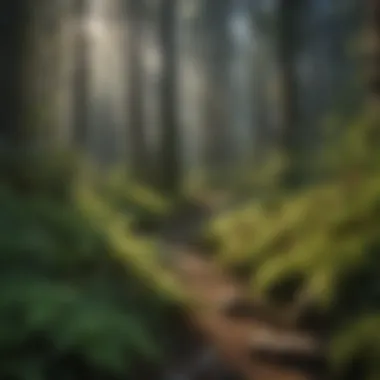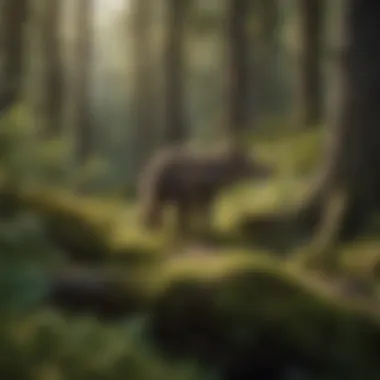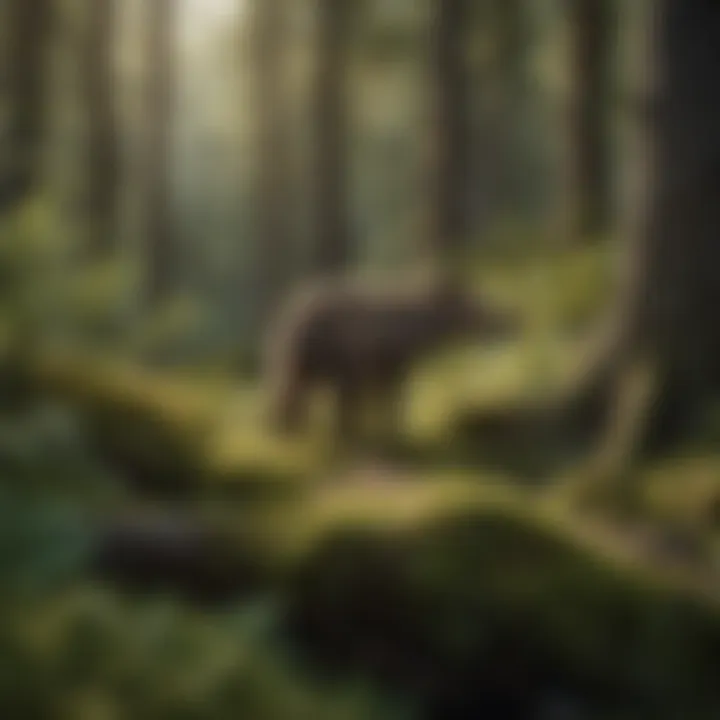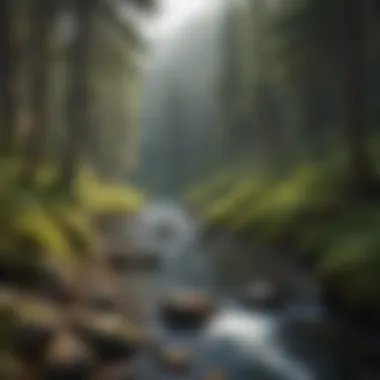Exploring the Wild Rogue Wilderness: A Comprehensive Study


Intro
The Wild Rogue Wilderness is a hidden gem nestled in southern Oregon, offering a rich blend of natural beauty and ecological importance. It's a place where towering evergreen trees dominate the landscape, providing shelter for various wildlife species and contributing to the overall health of the environment. This melting pot of different ecosystems raises questions about conservation practices in modern forestry. The Wild Rogue Wilderness isn't just a backdrop for outdoor activities; its intricate fabric of flora and fauna plays a fundamental role in maintaining ecological balance. By examining this unique wilderness, we dive into its vital characteristics, the ongoing conservation challenges it faces, and the broader implications for sustainable forestry management.
Evergreen Trees Species
Evergreen trees stand as resilient sentinels in the Wild Rogue Wilderness. They are inextricably linked to the health and stability of the ecosystem they inhabit.
Types of Evergreen Trees
Within these woods, several species of evergreen trees thrive. For instance, Douglas Fir (Pseudotsuga menziesii) is prominent, known for its remarkable height and robust timber. Then there's the Western Red Cedar (Thuja plicata), which is revered both for its beauty and its decay-resistant wood, often used in construction and crafting.
Beyond these, the Noble Fir (Abies procera) and the Grand Fir (Abies grandis) offer a distinctive forest fragrance and a vital habitat for various species. Each tree in these woods tells a unique story, contributing to the diverse tapestry of plant life that underpins the ecosystem.
Ecological Significance
Evergreen trees provide indispensable ecological benefits. They play a pivotal role in carbon sequestration, which helps mitigate the impacts of climate change. Their leaves are designed to withstand harsh winters, allowing them to photosynthesize year-round, thus continuously absorbing carbon dioxide from the atmosphere.
Moreover, the thick canopies they form create microclimates, fostering an environment where other species can flourish. Birds, mammals, insects, and a host of other organisms depend on these trees for food and shelter. Their roots anchor the soil, preventing erosion and maintaining water quality in the watersheds.
Conservation Practices
However, the well-being of these evergreens is not guaranteed. Various conservation practices are necessary to ensure their survival. Active management strategies, such as selective logging, allow for responsible timber extraction while maintaining healthy tree populations. Reforestation initiatives, featuring native species, help restore ecosystems that have faced degradation.
More importantly, involving local communities in conservation efforts establishes a sense of stewardship toward these natural resources. Educational programs can enlighten individuals about the importance of preserving the Wild Rogue's unique characteristics while fostering sustainable practices that extend beyond its borders.
"Promoting forest sustainability isn’t just a local endeavor; it requires global awareness and collective action."
As we explore the Wild Rogue Wilderness, we gain insights not only into its evergreen trees but also into the broader principles of forestry management and conservation vital to protect this splendid corner of our planet.
Prolusion to the Wild Rogue Wilderness
The Wild Rogue Wilderness stands as a vital enclave of ecological significance, tucked within the scenic landscape of southwestern Oregon. In this article, we aim to unwrap the layers of this wilderness area, revealing not only its diverse ecosystems but also its cultural and historical context. Understanding the importance of the Wild Rogue Wilderness is crucial because it offers insights into effective conservation practices, provides habitat for numerous species, and showcases the beauty of untouched nature that so many strive to protect.
This introduction will set the stage by highlighting the unique characteristics and intrinsic value of this wilderness, ultimately framing the discussion on why preserving such areas matters.
Geographical Overview
The Wild Rogue Wilderness encompasses approximately 35,000 acres of rugged terrain that defines the landscape of the region. Nestled between the jagged peaks of the Siskiyou Mountains and the meandering Rogue River, this wilderness exhibits a diverse range of geographical features. From steep cliffs to lush riverbanks, it showcases an expansive variety of habitats.
The area is marked by its significant elevation changes; it starts at around 1,000 feet near the Rogue River and rises to over 5,000 feet in its higher reaches. This elevation gradient drives an array of microclimates, contributing to the wilderness's rich tapestry of vegetation and wildlife. The hydrology of the area is equally remarkable, with numerous streams, tributaries, and waterfalls acting as vital lifelines for both flora and fauna. Importantly, the Rogue River itself is designated as a National Wild and Scenic River, adding another layer to its geographical impressiveness.
In terms of accessibility, the Wild Rogue is bordered by several main highways and trails, yet its ruggedness keeps it somewhat isolated and pristine. Visitors may encounter wildflowers blooming in the spring, only to navigate through thick forests of conifers as elevation increases. Whether you are among seasoned hikers or curious explorers, the geographical features of the wilderness invite discovery and introspection.
Historical Context
Delving into the historical context of the Wild Rogue Wilderness aids in appreciating its current state. Indigenous tribes, such as the Shasta and the Takelma, were the first stewards of this land. Their deep connection to the wilderness is reflected in traditional practices, stories, and rituals that have been passed down through generations. For these tribes, the land was not merely a resource but a cultural hallmark that defined their existence. Hunting, fishing, and gathering within the wilderness formed the backbone of their livelihood.
With European settlers arriving in the 19th century, this intricate relationship faced significant challenges. The influx led to extensive land use changes, including logging and mining, which heavily impacted the ecological balance of the area. Over time, the delicate ecosystems were threatened, leading to calls for conservation.
By the late 20th century, efforts began to large-scale preservation, culminating in the designation of the Wild Rogue Wilderness in 1984. This was a major victory for conservationists, paving the way for modern preservation efforts and understanding of sustainable practices. The ongoing engagement from tribal representatives, environmental organizations, and the public continues to shape the historical narrative of this landscape, ensuring that the richness that came before is not lost to time.
"The Wild Rogue Wilderness isn't just a place on the map. It is a living narrative, weaved through time by the hands and hearts of those who have called it home."
Understanding these layers of history is significant, as it prepares us to approach the wilderness with respect, recognizing the footprints of those who walked before us and the ongoing efforts needed to safeguard its future.
Ecological Significance of the Wilderness
The ecological significance of the Wild Rogue Wilderness can't be overstated. This expanse serves as a vibrant sanctuary for numerous species and habitats, forming a crucial part of the larger environmental tapestry. The unique characteristics of this wilderness area exemplify the integration of diverse ecosystems, offering myriad benefits both to the environment and to humanity. The concept of ecological significance extends beyond mere biodiversity; it encapsulates the essential roles these natural spaces play in regulating climate, conserving water, and enhancing overall ecological balance.
Diversity of Flora
The flora found within the Wild Rogue Wilderness is as varied as it is vital. Home to hundreds of plant species, it showcases an impressive range of ecosystems, from lush forests of coniferous trees to more arid shrublands. One might stumble upon towering Douglas firs and ancient Redwoods standing sentinel over the forest floor, rich with undergrowth. The abundance of plant life fosters a robust ecosystem that supports wildlife, stabilizes soil, and aids in carbon sequestration — an essential process in combating climate change.


Moreover, the seasonal changes provide a living canvas of color and texture, enriching the landscape with cycles of flowering and dormancy. For instance, species such as the delicate Western Trillium bloom in spring, offering food and shelter to various insects, while robust huckleberries produce berries that many animals rely on for sustenance in late summer. Minimal human interference has allowed these species to thrive, preserving genetic diversity which is crucial for resilience against disease and environmental shifts.
Unique Fauna
Transitioning from the delicacy of flora to the remarkable fauna, the Wild Rogue Wilderness is a treasure trove of wildlife. It hosts a variety of mammal species, including the majestic Roosevelt Elk, which roam freely through the diverse habitats. Observing these creatures in their natural environment is a reminder of the wild's raw beauty and the interconnectedness of life forms.
Birdwatchers and nature enthusiasts will also find delight in the numerous avian species that inhabit this wilderness. From the haunting call of the Great Horned Owl at dusk to the cheerful songs of various warblers, the symphony of bird life adds a rich auditory layer to the experience of being in nature. The area's streams and rivers create vital habitats for fish, particularly the native Coho salmon, which are critical not just ecologically but also culturally.
"The Wild Rogue Wilderness is a living library of biodiversity, its flora and fauna a testament to nature's resilience and adaptability."
Yet, these unique species face significant threats. Changes in climate conditions, habitat disruption, and encroachment from urban areas create stress on these ecosystems. Understanding and mitigating these challenges is essential for maintaining the ecological integrity of the region, ensuring that future generations can appreciate its unique biodiversity. With each element, from the smallest wildflower to the largest megafauna, there exists a delicate balance that illustrates the interdependence of life. Hence, the ecological significance of the Wild Rogue Wilderness extends far beyond its boundaries, reminding us of our collective responsibility to protect such irreplaceable natural treasures.
Landscape Features and Topography
The landscape and topography of the Wild Rogue Wilderness is not just an aesthetic feature; it shapes the entire ecological narrative of the area. It contributes to biodiversity and influences the climatic conditions, creating various habitats for both flora and fauna. Understanding the rugged terrain and its elevation variations, along with the presence of water bodies, unveils the intricate connections that underscore this wilderness.
Rugged Terrain and Elevation Variations
One of the defining characteristics of the Wild Rogue Wilderness is its rugged terrain, marked by steep hills, deep canyons, and rocky outcrops. The elevation within the area fluctuates significantly, leading to distinct microclimates. As one ascends from the valley floors to the mountain ridges, the variations in altitude contribute to diverse plant and animal communities. For example, the cooler climates at higher elevations support species like Douglas fir and western hemlock, while the lower elevations can sustain warmer, drier environments with species such as oaks and manzanita.
- Climatic Factors: The elevation differences can create significant climate gradients. This means that areas facing the sun get warmer during the day while shaded slopes remain cooler.
- Erosion and Soil Development: The steepness in the area contributes to natural erosion processes. This leads to the formation of varied soil types that play a critical role in the health and distribution of vegetation.
These factors combine to foster complex dynamics among species, therefore it's no surprise that such a rich array of organisms calls the Wild Rogue Wilderness home.
Water Bodies and Their Impact on Ecosystems
Water bodies, ranging from rivers to smaller streams, are essential to the Wild Rogue Wilderness's ecosystems. They create a lifeline for various species and contribute immensely to the ecological sustainability of the area. The Rogue River, for instance, has cut through the landscape, helping to shape its contours over millennia.
- Habitat Creation: The streams and rivers provide unique habitats for aquatic life, serving as breeding grounds for fish like salmon. These water bodies also promote the presence of amphibians and various invertebrates.
- Nutrient Cycling: Water bodies also facilitate nutrient cycling, as they transport essential minerals and organic material downstream, nourishing ecosystems as they flow. When these nutrients reach land, they help in sustaining vegetative growth, which is vital for soil health.
- Climate Regulation: Additionally, water bodies regulate local microclimates; they can influence humidity levels and local temperatures, impacting overall biodiversity in the area.
Understanding the role of topographical features like rugged terrains and water bodies reveals the interconnectedness of nature, emphasizing the need for responsible stewardship of the Wild Rogue Wilderness to ensure these ecosystems remain vibrant.
Human Interaction and Impact
Human interaction with natural wilderness areas such as the Wild Rogue Wilderness has shaped both the environment and the local community in varied ways. Understanding this topic is crucial because it highlights the delicate balance between utilizing natural resources and ensuring their preservation for future generations. On one hand, historical land uses reflect the transformation and sometimes the degradation of the landscape, while current preservation efforts reveal the ongoing attempts to mitigate past impacts and safeguard ecological integrity.
Historical Land Use
Historically, the Wild Rogue Wilderness has been subject to a variety of land uses that stemmed from settlers and industries. The hunting and gathering practices of Native American tribes laid the foundation for early interactions with the land, fostering a deep-rooted relationship with the ecosystem. These communities understood seasonal patterns and ecological interdependencies, which guided their sustainable practices.
As the region began to see settlers come in the 19th century, the land usage evolved drastically.
- Logging Industry Expansion: The timber boom led to extensive logging, altering the landscape significantly. Ridgetops were denuded, leading to soil erosion and habitat loss.
- Agricultural Practices: Farming encroached into the wild areas, sometimes causing fragmentation of habitats. These activities often favored certain plant species while dwindling others into local oblivion.
- Mining Activities: The extraction of minerals and resources contributed to pollution in nearby water bodies, affecting wildlife and reducing biodiversity.
Each of these land uses left an imprint, some irreversible, that demands reflection and learning for future land management decisions. Acknowledging this history is essential for fostering a responsible stewardship mindset among current and future generations.
Current Preservation Efforts
In response to the historical impact on the Wild Rogue Wilderness, numerous preservation efforts have been put in place to protect and restore the natural environment. These initiatives stem from the understanding that past actions cannot be erased, but new pathways can be paved towards resilience.
- Federal Designation: Protected status under federal laws helps limit certain harmful activities that could jeopardize the area’s ecological balance. The Wilderness Act effectively protects the Wild Rogue from development and industrial exploitation.
- Habitat Restoration Projects: Local organizations work tirelessly to restore degraded ecosystems by replanting native species and removing invasive ones. This nurtures the habitats that foster vitality in the region's diverse wildlife.
- Community Involvement: Engaging local communities in monitoring environmental conditions promotes a sense of ownership. Volunteer programs focus on restoration, clean-up, and educational outreach, ensuring that the wisdom of past interactions informs present practices.
- Sustainable Recreation Initiatives: Modern practices strive to integrate recreational activities like hiking and camping with conservation goals, ensuring trails are designed with minimal impact on natural habitats.
"The wilderness is not a luxury but a necessity of the human spirit."
— Edward Abbey
Through these concerted efforts, there is a hopeful outlook for the Wild Rogue Wilderness. Effective collaboration between government, local organizations, and individuals ensures not just a recovery from historical impacts but also a flourishing for the diverse life forms that call this unique environment home.
Conservation Challenges in the Wild Rogue Wilderness
The Wild Rogue Wilderness undoubtedly stands as one of the most vital ecologies in the Pacific Northwest. However, it is not without its conservation challenges. Addressing these issues is crucial for maintaining the unique beauty and biological richness of this area. Whether it’s safeguarding its diverse habitats or ensuring that wildlife can thrive unimpeded, understanding the conservation challenges in this wilderness area is key to any discussion about its future.
Threats from Pollution
Pollution stands as a formidable adversary in the fight for conservation. Runoff from agricultural activities, industrial emissions, and even litter can mysteriously find its way into the waterways of the Wild Rogue, affecting both the flora and fauna residing there. For example, pollutants can alter water chemistry, making it less hospitable for species like the native salmon, which thrive in clean, cool water.


One consequence of this pollution is the disruption of food chains. Imagine a fish population dwindling because it can’t find clean water and, subsequently, how that impacts animals that depend on them for sustenance. Birds, large predators, and even the microorganisms that populate the soil rely on this intricate network.
To tackle this, immediate attention is required. Local communities need to implement sustainable practices. Everyone, from farmers to city dwellers, has a role to play. Initiatives like community clean-up days or awareness programs about proper waste disposal might seem small but can lead to larger shifts in behavior.
"Pollution does not merely affect the immediate surroundings; its effects ripple through everything in the ecosystem, challenging the very fabric of biodiversity."
Invasive Species Recommendations
Invasive species present another layer of complexity. These non-native organisms often infiltrate the delicate ecosystems, outcompeting native species for resources and disrupting habitats. The introduction of species like the blackberries and various thistles has already put pressure on local plants that have evolved over centuries to thrive in that environment.
What can be done? Here are a few recommendations:
- Awareness Campaigns: Informing the public about not planting invasive species in gardens can prevent future introductions.
- Monitoring: Regular ecological assessments can help identify invasive species early, which can lead to swift management responses.
- Restoration Projects: After removing invasive species, initiatives to plant natives can help restore balance to the ecosystem.
Conservation is not just a responsibility; it’s a necessity to protect this wilderness for future generations. Any slight impact can resonate through time, making proactive measures imperative. Only then can we hope to preserve the Wild Rogue Wilderness in all its glory.
The Role of Sustainable Forestry
Sustainable forestry plays a pivotal role in maintaining the ecological integrity of areas like the Wild Rogue Wilderness. It straddles the line between meeting human timber demands and ensuring that forest ecosystems thrive for generations to come. In this context, it’s not merely about planting trees or cutting them down; it’s about doing so with a keen awareness of the wider impacts on the environment. This ensures that both the ecosystems and our communities can flourish together.
Principles of Sustainable Practices
At the heart of sustainable forestry are a set of principles that guide decision-making and practices to uphold forest health. Here are fundamental principles that should be kept in mind:
- Environmental Protection: This principle revolves around minimizing the negative impact on wildlife and water quality, ensuring that forest operations do not disrupt local ecosystems.
- Socio-Economic Viability: Economic considerations shouldn’t overshadow ecological integrity. Sustainable forestry looks to balance the needs of the local community with the health of the forest.
- Biodiversity Conservation: Maintaining a rich variety of species is crucial. Diverse forests are more resilient to diseases and climate variations, which in turn supports a robust ecosystem.
- Adaptive Management: This flexible approach allows for adjustments based on new information or changing conditions, ensuring that forestry practices remain relevant and effective over time.
By adhering to these principles, forestry professionals can foster landscapes that are not only productive but also resilient to the pressures of climate change and human encroachment.
Benefits for Local Ecosystems
Integrating sustainable forestry practices does more than just ensure timber yield; it also provides a bundle of benefits to local ecosystems, contributing to overall health and stability.
- Increased Carbon Sequestration: Healthy forests are substantial carbon sinks, absorbing carbon dioxide from the atmosphere, which helps mitigate climate effects.
- Soil Health Improvement: Sustainable practices like reduced tillage and maintaining ground cover enhance soil quality, leading to improved water retention and reduced erosion.
- Water Regulation: Forests play a vital role in maintaining watershed health. Sustainable forestry manages water flow and reduces run-offs, protecting aquatic systems.
- Habitat Preservation: Responsible forest management helps maintain habitats for various species, supporting both flora and fauna diversity and ensuring food chains remain intact.
- Community Well-being: Lastly, sustainable forestry has direct benefits for human communities via job creation, recreational opportunities, and the cultivation of a connection to nature that fosters stewardship.
In sum, sustainable forestry is not just a trend; it's a necessary approach for ensuring that the delicate balance of our natural world is maintained. By viewing forestry through this responsible lens, the Wild Rogue Wilderness can thrive, serving both ecological and human interests for years to come.
"Sustainable forestry isn’t just about conservation; it's about creating a pathway for coexistence with nature, where benefits abound for the land, its inhabitants, and us."
For more in-depth material on sustainable forestry practices, consider exploring resources from institutions like Wikipedia and Britannica.
This understanding of sustainable forestry in the Wild Rogue Wilderness shines a light on the broader issue of conservation, encouraging a hands-on approach among forestry professionals and enriching the academic dialogue surrounding the practices that can save our ecosystems.
Biodiversity and Ecosystem Health
Biodiversity and ecosystem health serve as the backbone of any wilderness area, including the Wild Rogue Wilderness. These interconnected concepts are not just scientific lingo; they have real implications for the landscape and the multitude of life forms inhabiting it. A rich diversity of species ensures resilience against environmental changes and stresses, making it essential for the stability of ecosystems. When species thrive, ecosystems tend to function better, supporting everything from plant growth to nutrient cycling.
Indicator Species and Their Importance
Indicator species are like canaries in the coal mine, providing insight into the health of their environments. These organisms respond predictably to changes such as pollution, habitat loss, or climate shifts, acting as signals of the overall ecosystem's condition. For instance, the presence of certain amphibians in the Wild Rogue, like the Pacific Tree Frog, can indicate clean water and a healthy habitat, while their decline may suggest underlying issues that need urgent attention.
Furthermore, these species often play crucial ecological roles, serving as prey for larger animals or controlling insect populations. If we take a closer peek, we can see how they contribute to the balance of the ecosystem. When their population numbers fluctuate, it can tell us a lot about the broader state of biodiversity in the wilderness. Thus, monitoring these indicators is vital for conservation efforts in the Wild Rogue Wilderness.
Ecosystem Services Provided by Wilderness Areas
Wilderness areas like the Wild Rogue provide a buffet of ecosystem services that sustain both the environment and human communities.
- Clean Water Supply: Healthy ecosystems filter water, ensuring that streams and rivers remain clean for wildlife and humans alike.
- Carbon Sequestration: Forests in the wilderness absorb significant amounts of carbon dioxide, helping mitigate climate change.
- Soil Stability and Fertility: Diverse plant life anchors the soil, preventing erosion and enhancing nutrient content.
- Habitat for Wildlife: These areas serve as sanctuaries for countless animal species, fostering breeding and foraging opportunities.
- Recreational Benefits: People are drawn to these untouched landscapes, attracting visitors for hiking, camping, and other outdoor activities, contributing to local economies.
In summary, the Wild Rogue Wilderness does not merely exist as a collection of trees and streams; it functions as an intricate web of life that contributes to ecological stability and offers numerous benefits essential to overall health of the planet.
The protection of biodiversity in the Wild Rogue ecosystem isn't just an environmental concern; it is fundamentally linked to human well-being.
Understanding and emphasizing the importance of these elements is crucial for maintaining and improving the health of the Wild Rogue Wilderness now and into the future.


Cultural Significance of the Wilderness
The Wild Rogue Wilderness is not merely a patch of untouched nature; it is a living narrative intricately interconnected with human history and cultural identity. This section unpacks the layers of significance associated with this vast natural expanse. Understanding its cultural dimensions allows us to grasp the full essence of the wilderness, which goes beyond physical beauty to include heritage, traditions, and recreational activities that enrich our lives.
Native American Heritage
Among the first stewards of this wilderness are the Native American tribes, whose ties to the land run deep, rooted in both sustenance and spirituality. Tribes such as the Rogue River, Takelma, and Klamath have thrived in harmony with the region's ecosystems for thousands of years. Their cultural narratives encompass a profound respect for the natural world and an understanding of the symbiotic relationship between humans and nature. Historic sites across the wilderness reveal ancient trails, sacred sites, and fishing locations that illuminate their traditional ecological knowledge.
Through practices such as controlled burning, these tribes enacted land management strategies aimed at promoting biodiversity and preventing catastrophic wildfires. Their knowledge is invaluable, showcasing a masterful balance between harvesting resources and protecting the environment. For instance, the use of fire was not merely a tool for clearing land but a ritual aimed at fostering growth and resilience within the ecosystem.
In today’s world, initiatives to revive indigenous land management practices can provide contemporary insights into conservation efforts. Programs that focus on collaboration between Native American groups and conservationists foster a deeper understanding of ecological stewardship while honoring the cultural heritage of the land.
Modern Recreational Activities
As we move from the past to the present, the Wild Rogue Wilderness has transformed into a vibrant hub for various recreational pursuits. These modern activities not only offer an escape from the hustle and bustle of daily life, but they also raise awareness about the importance of conservation. Hiking, kayaking, and birdwatching attract a diverse crowd, from seasoned adventurers to families seeking a connection with nature.
The trails winding through the wilderness present an array of experiences. For instance, the Rogue River Trail leads you through stunning landscapes, showcasing the area's geological diversity and allowing for glimpses of its wildlife. Each step taken is a nod to the land's cultural richness and the stories it holds. Such immersion encourages visitors to reflect on their role in the preservation of these natural treasures.
Moreover, outreach programs intended for education and engagement bolster community involvement. These initiatives emphasize sustainable practices among recreationists, turning thrill-seekers into stewards of the wilderness. Forest clean-up events, guided tours highlighting ecological importance, and educational workshops serve to deepen visitors' appreciation.
"Engagement goes beyond pleasure; it's about developing a community that respects and cares for the Wild Rogue Wilderness."
The Future of the Wild Rogue Wilderness
The path ahead for the Wild Rogue Wilderness is indeed a compelling one. The decisions we make today will resonate through generations, impacting the delicate balance of its ecosystem. This wilderness area, rich in biodiversity and featuring stunning landscapes, is not just a backdrop for our leisure activities; it plays a critical role in maintaining environmental health. Therefore, understanding future expectations and initiatives is paramount for anyone interested in promoting effective conservation strategies.
Expectations and Projects
Looking forward, there are several high-priority projects and expectations for the Wild Rogue Wilderness that demand our attention. These efforts primarily hinge on enhancing both conservation and recreation, ensuring that the wilderness remains viable for both human enjoyment and ecological integrity. Some crucial projects include:
- Restoration Initiatives: Projects aimed at restoring degraded areas, especially where invasive species have taken root, will prove essential. By implementing targeted restoration strategies, we can rejuvenate native flora, allowing it to reclaim its rightful place in the ecosystem.
- Monitoring Programs: Establishing comprehensive monitoring initiatives can help us track ecosystem changes over time. This data is pivotal in adapting management strategies to mitigate future challenges brought about by climate change and human interference.
Engagement with local experts and stakeholders will be central to these projects. Collaborative approaches will ensure that diverse insights contribute meaningfully to stewardship efforts, enhancing the resilience of this treasured wilderness.
Community Involvement Initiatives
Involving the community is key to fostering stewardship in the Wild Rogue Wilderness. It’s not just about preserving the wilderness but nurturing a communal ties to the land. There are various initiatives that engage local populations in meaningful ways:
- Volunteer Programs: Organizing volunteer days for trail maintenance or habitat restoration allows locals and visitors alike to get their hands dirty while appreciating the natural beauty surrounding them. Such involvement breeds a sense of connection—people will protect what they love.
- Educational Workshops: Hosting workshops focused on sustainable practices can educate community members about the ecological significance of their actions. Everyone can glean knowledge about local flora and fauna, guiding sustainable behavior that benefits the wilderness.
- Partnerships with Local Organizations: Forming partnerships with local non-profits and educational institutions can amplify efforts. By aligning with groups that share common goals, such as conservation and sustainability, initiatives can have a broader impact.
Involving the community will not only heighten awareness but also ensure that conservation strategies resonate more deeply with those who live and recreate in the area.
"The wild spaces we cherish require not just our admiration, but our active participation and care."
The outlook for the Wild Rogue Wilderness hinges on collective responsibility and an unwavering commitment to balance preservation with the engagement of those who are most connected to it.
Ending: The Balance Between Preservation and Engagement
The discussion surrounding the Wild Rogue Wilderness brings us to a pivotal moment between conservation efforts and community involvement. This balance is crucial because it not only guarantees the survival of this pristine ecosystem but also nurtures a sense of ownership among those who cherish its beauty. The wilderness is more than just a collection of trees and rocks; it embodies a rich tapestry of cultural history, ecological value, and potential recreational opportunities. As these elements interweave, our responsibility to protect this environment becomes increasingly significant, highlighting the intricate relationship between land and its stewards.
Reflecting on Human Responsibility
Human beings play a central role in the fate of the Wild Rogue Wilderness. Our interactions with nature leave an imprint that can either harm or enhance the environment. The notion that we are guardians of the land is not merely philosophical; it has tangible implications for ecological health. It's paramount to examine our historical conduct, where resource exploitation once reigned supreme, leading to detrimental outcomes for local ecosystems. Today, however, there's a shift toward a more enlightened understanding of our role.
This change is visible in the growing awareness of sustainable practices that respect the ecological balance. Individuals and organizations alike are embracing responsible behaviors, advocating for better policies that safeguard natural habitats. The principle of leave no trace, for instance, resonates strongly with hikers, campers, and outdoor enthusiasts. It's about doing less harm, preserving the integrity of the environment so that it remains for future generations to enjoy.
"We do not inherit the earth from our ancestors; we borrow it from our children."
This quote encapsulates the very essence of our duty and serves as a reminder that while we enjoy the wonders of the wilderness, we also bear a responsibility—one that is steeped in respect and sustainability.
Encouraging Personal Participation
Beyond individual awareness, community engagement stands as a crucial pillar for the future of the Wild Rogue Wilderness. Encouraging locals and visitors to participate actively in conservation isn't just beneficial; it's necessary. Workshops, educational programs, and volunteer days for trail maintenance or habitat restoration can foster a deeper connection to the land.
When community members participate, they become invested in the health of the ecosystem. Here are some compelling ways to promote active involvement:
- Organized Clean-up Days: These events not only remove debris but also raise awareness about pollution's impact on wildlife.
- Educational Tours: Guided experiences can illuminate the unique features of the wilderness, fostering appreciation while teaching about fragile ecosystems.
- Partnerships with Schools: Engaging younger generations can build a legacy of conservation-minded individuals who understand the importance of preserving natural resources.
Ultimately, the synergy between preservation and engagement can yield considerable benefits. Notably, when individuals invest time and energy into the Wild Rogue Wilderness, the results are often profound; the health of ecosystems improves, community ties are strengthened, and a culture of stewardship emerges.
As we move forward, let us keep this balance in our sights, recognizing that the Wild Rogue Wilderness is a magnificent, living resource that thrives through both protection and passionate engagement.



